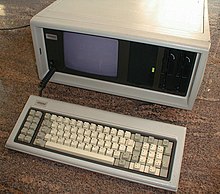 A Compaq Portable with the keyboard detached ready for use. This machine has an aftermarket hard disk and floppy disk drives added. | |
| Manufacturer | Compaq Computer Corporation |
|---|---|
| Product family | Compaq Portable series |
| Type | Portable computer |
| Release date | March 1983 |
| Introductory price | US$2,995 (equivalent to $9,160 in 2023) |
| Operating system | MS-DOS |
| CPU | Intel 8088, 4.77 MHz |
| Memory | 128 KB (expandable to 640 KB) |
| Storage | Two 5.25" floppy disk drives or, optionally, one floppy drive and a 10 MB hard drive |
| Display | Built-in 9" green screen monitor |
| Graphics | Unique CGA-compatible video card |
| Mass | 28 lb (13 kg) |
| Backward compatibility | IBM PC compatible |
| Successor | Compaq Portable Plus |
The Compaq Portable is an early portable computer which was one of the first IBM PC compatible systems. It was Compaq Computer Corporation's first product, to be followed by others in the Compaq Portable series and later Compaq Deskpro series. It was not simply an 8088-CPU computer that ran a Microsoft DOS as a PC "work-alike", but contained a reverse-engineered BIOS, and a version of MS-DOS that was so similar to IBM's PC DOS that it ran nearly all its application software. The computer was also an early variation on the idea of an "all-in-one".
It became available two years after the similar, but CP/M-based, Osborne 1 and Kaypro II. Columbia Data Products' MPC 1600 "Multi Personal Computer" had come out in June 1982.[1][2] Other "work-alikes" included the MS-DOS and 8088-based, but not entirely IBM PC software compatible, Dynalogic Hyperion,[3] Eagle Computer's Eagle 1600 series, including the Eagle Spirit portable,[4] and the Corona personal computer.[5] The latter two companies were threatened by IBM for BIOS copyright infringement, and settled out of court, agreeing to re-implement their BIOS.[6] There was also the Seequa Chameleon, which had both 8088 and Z80 CPUs to alternately run MS-DOS or CP/M.[7][8][9] Unlike Compaq, many of these companies had previously released computers based on Zilog's Z80 and Digital Research's CP/M operating system. Like Compaq, they recognized the replicability of the IBM PC's off-the-shelf parts, and saw that Microsoft retained the right to license MS-DOS to other companies. Only Compaq was able to fully capitalize on this, by aiming for complete IBM PC and PC DOS software compatibility, while reverse-engineering the BIOS to head off copyright legal claims.
Other contemporary systems include the portable Commodore SX-64, also known as the Executive 64, or VIP-64 in Europe, a briefcase/suitcase-size "luggable" version of the popular Commodore 64 home computer built with an 8-bit MOS 6510 (6502-based) CPU microprocessor, and the first full-color portable computer.[10] Like the Z80 and "work-alike" portables, its sales fell into insignificance in the face of the Compaq Portable series.
- ^ "History of the Microprocessor and the Personal Computer, Part 3". TechSpot. 8 May 2020. Retrieved 2021-08-23.
- ^ Aboard the Columbia, By Bill Machrone, Page 451, June 1983, PC Mag
- ^ David Thomas, Knights of the New Technology: The Inside Story of Canada's Computer Elite, Key Porter Books, 1983 ISBN 0-919493-16-5 pp. 172-179
- ^ Pournelle, Jerry (September 1983). "Eagles, Text Editors, New Compilers, and Much More". BYTE. p. 307. Retrieved 2021-05-14.
- ^ "Corona advertisement", InfoWorld, p. 50, July 18, 1983, retrieved 14 May 2021
- ^ Sanger, David E. (1984-06-09). "EAGLE'S BATTLE FOR SURVIVAL". The New York Times. ISSN 0362-4331.
- ^ Hardware:Review:Seequa Chameleon, By Russ Adams, Page 132, 28 November 1983, InfoWorld
- ^ The Chameleon mystery, By David Needle, Page 5, 31 January 1983, InfoWorld
- ^ Review Responses: Seequa, By John Schaefer, Page 66, 30 January 1984, InfoWorld
- ^ "Compaq Commodore 64". www.vintage-computer.com. Archived from the original on 3 July 2018. Retrieved 6 December 2022.